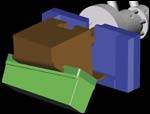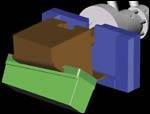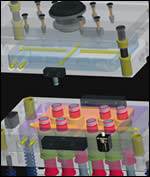Using TiN Coatings to Protect Your Knock-out/Ejector Pins
Proper surface treatments for enhancing corrosion resistance of mold components in molding situations.
Making a better product to survive has never meant more than in today’s global manufacturing environment. For a company to succeed it is not enough just to make a good product. You have to be solving someone’s problems. Mold components are no exception in helping to keep tools running and making superior products that are right the first time.
The Component Coating Solution
One such device that solves people’s problems is the ejector pin. Often considered a commodity, they are nonetheless critical to the successful function of a mold. The list of what can go wrong due to problems with them is endless. One important enhancement to the function of the ejector pin is TiN coating (also called nitriding). It is a means of helping solve many of the ills that can befall an ejector pin. There are many advantages and a few considerations to be accounted for as well with this tool. The coating zeros in on many of the needs of a long-lasting and successful ejector pin.
1. First, the pin must wear well from all the movement required. The sliding contact between the internal mold surface and the pin can be severe depending on the part being ejected. Most parts have several ejector pins per cavity so it is very important that they move well together. The major advantage provided here is a low coefficient of friction. This helps provide rapid and accurate movements when clearing the mold between cycles.
A stuck part—either in the mold or on a pin—can be catastrophic to product quality not to mention mold integrity. TiN coating provides this feature around a coefficient of friction down to approximately 0.6. Parts release much more reliably and predictably. The best means of preventing damage due to a stuck part is not to have it happen to begin with.
2. Second, the pin needs to be versatile enough to be used in varied environments of both temperature and chemical extremes. Here chemical inertness and dimensional stability are key.
The TiN coating itself is more stable and chemically inert than the stainless steel surfaces themselves they often coat.
It is commonly used in high level medical applications and it offers stability to oxidation at temperatures up to 600°C. Being unaffected by nearly all operating environments it finds itself in, it provides very cost-effective processing advantages with nearly no drawbacks. Being able to stock one type of pin also represents a great cost savings to a busy shop molding a wide variety of materials.
3. Third, dimensional stability of the pins is key due to their workload. Mushrooming is a common problem that is dealt with by the up to Rockwell 85 C surface placed on it. This also helps prevent galling that can lead to stuck pins and damaged cavities or worse. The predictable thickness of the coating—which is generally around 0.00008-inch for the most part—does not even come into play functionally on standard tolerances of a pin.
One other advantage related to the thickness of the coating is that the process can be redone over an existing treated pin. Two such coatings on a pin typically still represent a very usable diameter in the same tooling without rework. If re-coating is necessary, there are no stripping charges in between.
Before You Start
There are some considerations that need to be addressed prior to implementation:
- The color is generally that of a metallic gold color for the life of the component. This can be a problem if it interferes with the part cosmetically.
- Masking certain areas to preserve other part properties can be very costly and should be avoided if possible. Fortunately, that is generally not an issue with ejector pins.
- Certain metals that cannot take the elevated temperatures and vacuum of the process (i.e. lead, zinc in other than trace amounts and cadmium) should be avoided. They will vaporize during the process. A clean bright surface finish is required and it is more cost-effective for the customer to provide the parts in that state to the company performing the coating.
Summary
Global competitiveness in injection molding today requires both a sound technical plan as well as a good productivity plan in order to make money and survive. It isn’t enough to make people think you’re more capable than the rest. You really have to be better.
Components used in these molds need to contribute more than ever before and in a very cost-effective manner. TiN coating meets both of these needs through a low coefficient of friction, high hardness and being chemically inert. It is certainly a necessity nowadays to help you stay competitive in today’s global economy.
Related Content
Considerations for Mold Base Material Selection
Choosing the right material can greatly affect the profitability and cost of your application.
Read MoreMachining Center Spindles: What You Need to Know
Why and how to research spindle technology before purchasing a machining center.
Read MoreHow to Eliminate Chatter
Here are techniques commonly used to combat chatter and guidelines to establish a foundation for optimizing the moldmaking process.
Read MoreMaintaining a Wire EDM Machine
To achieve the ultimate capability and level of productivity from your wire EDM on a consistent, repeatable and reliable basis, regular maintenance is a required task.
Read MoreRead Next
The Advantages of New Modular Tech: Maximizing ROI and Minimizing Risk
Proven off-the-shelf modular mold components and complete component systems meet today’s demanding drive for a lean approach.
Read MoreAutomated In-Mold Marking for Plastic Injection Mold Tools
The importance of plastic part traceability and how to achieve it.
Read MoreDon’t Build the “Same Old Same Mold”
Steps for evaluating the latest mold innovations in order to move along the evolution process.
Read More














.png;maxWidth=300;quality=90)










